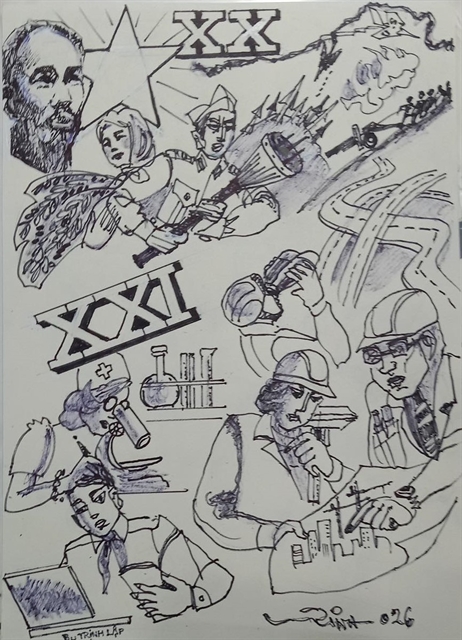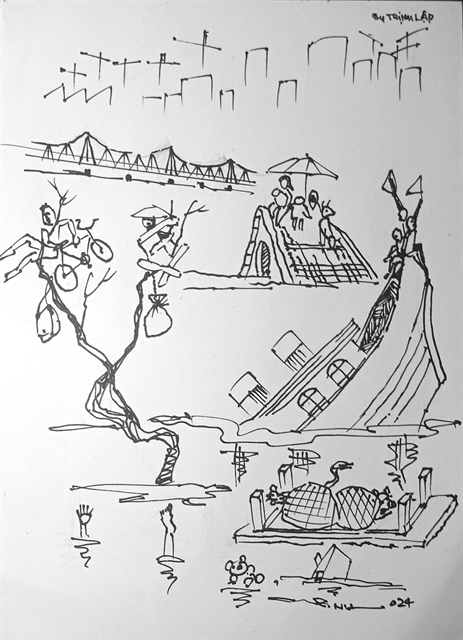 Talk Around Town
Talk Around Town

 |
| Illustration by Trịnh Lập |
by Nguyễn Mỹ Hà
Next month, the city of Hà Nội will celebrate its 70th year of liberation from French occupation during the First Indochina War. Images of French legion troops withdrawing from the city via Long Biên Bridge marked the end of French rule in the north of Việt Nam following the victorious battle of Điện Biên Phủ in May 1954.
Hanoians poured out from their homes to greet the victorious soldiers marching into the city on October 10, 1954, enjoying the fresh air of freedom, independence, and happiness.
Last week in this column, we had the chance to speak for the silent, age-old, and caring residents of the city—the street trees. This week, however, is dedicated to the living residents of the capital you might never think exist.
On the islet under the symbolic Long Biên Bridge spanning the Red River, there lives a community of people of all ages—from infants to the elderly, from those of working age to those retired—who need better living conditions.
Only a few days after Typhoon Yagi smashed through the northern provinces, Long Biên Bridge, closed to traffic for several days, was reopened this week. Tourists love the bridge, just like we Hanoians do. Walking across Long Biên Bridge has become almost a ritual for visitors. Little do they know, as they cross, that underneath them live people in such destitute conditions that they violate all standards for a living space.
And it’s not in a remote mountain or deep jungle inaccessible by vehicles. It’s only about 15 minutes from the city centre, where Hoàn Kiếm Lake and the City Hall are located.
Last year, a hit television series titled Cuộc Đời Vẫn Đẹp Sao (Life Is Beautiful) was filmed on this very spot and broadcast during prime time on national television, with millions of viewers.
After the Red River’s flood waters receded, traditional villages of farmers who grow peach blossoms and kumquat trees mourned the loss of flowers for the next Lunar New Year. But when the waters receded, the people living under Long Biên Bridge had to endure conditions you wouldn’t believe possible.
"Human love for each other during times of hardship" may sound pleasing to the ears of those who haven’t experienced it, but authorities in Hà Nội must be aware of this and take action.
This weekend marks two weeks since Yagi hit, yet villages in the suburban districts of Phúc Thọ, Thanh Oai, Chương Mỹ, Ứng Hòa, Mỹ Đức, Quốc Oai, Thạch Thất, Đông Anh, and Sóc Sơn remain submerged.
Communities living in homes along the Đáy River still endure stagnant floodwater as the river water withdraws slowly. Waste and garbage have filled village streets and homes. City health authority has warned of potential disease outbreaks. Guidance on cleaning homes, offices, and schools has been shared online, including tutorials on purifying water for daily use, provided by local community workers.
The rescue phase of delivering instant food and goods has shifted to the next phase—restoring normalcy to those whose lives were upended by the storm and floods.
Teams of technicians from across the country have headed to Thái Nguyên Province to help people repair rice cookers, refrigerators, and induction cooktops. The motorbike repair association from the central province of Thanh Hóa travelled to Lào Cai to change oil and fix motorbikes, all free of charge.
Rescue teams, arriving in lorries, vans, motorbikes, and three-wheelers, were greeted by children and women waving national flags at the entrance to the affected communities. Free kitchens set up along the roads offered rescuers hot meals, including rice, meat and soup.
On Mid-Autumn Full-Moon Day, a small group of children aged 3-9 in Suối Đá, Quảng Nam Province, performed a lion dance around the village, raising VNĐ2.1 million (nearly $100), which they asked their parents to send to the Fatherland Front to help those affected by the storm and floods.
In Việt Nam these days, the stories you hear and read about are heartwarming, lifting your spirits and strengthening your love for the country.
In a televised meeting, Prime Minister Phạm Minh Chính reassured the public that the government has been working at full speed, deploying army and police forces to assist with recovery efforts. He reaffirmed the leadership’s sole focus: “to make people’s lives better, and the country stronger”.
The meeting also featured a young boy who is to be adopted by the policeman who helped him during the storm. Broadcast live on national television, the boy, whose parents and little sister died in the storm, was asked to talk about his future.
Some, including myself, feel that this act of charity lacked empathy. Imagine a young child, having just lost his family, being made to share his deepest pain in front of the nation. He was too young to refuse, and when asked what he wanted to be when he grew up, he said he now has a new dad and wants to become a policeman.
Where are the children’s rights protectors? Where are the child psychologists? Speak up.
Those in the midst of the rescue efforts may not have the time to reflect on these events, but others, not on the front lines, should.
At present, Hà Nội’s leadership is likely preoccupied with helping the residents of nine suburban districts still underwater. But let’s hope that, in time, they will also focus on improving the life conditions of the community living under Long Biên Bridge. Hà Nội is now wealthier and more developed than it was 70 years ago. It can take better care of its residents. VNS




